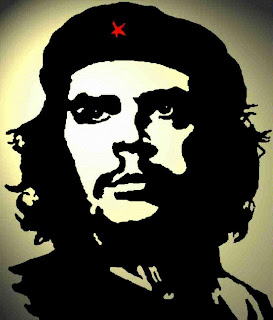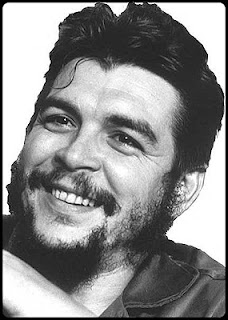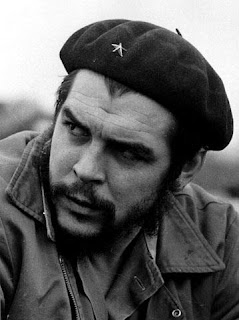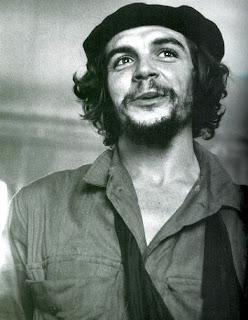 |
| Che Guevara |
Following the Cuban Revolution, Che Guevara performed a number of key roles in the new government. These included reviewing the appeals and firing squads for those convicted as war criminals during the revolutionary tribunals, instituting agrarian reform as minister of industries, helping spearhead a successful nationwide literacy campaign, serving as both national bank president and instructional director for Cuba’s armed forces, and traversing the globe as a diplomat on behalf of Cuban socialism. Such positions also allowed him to play a central role in training the militia forces who repelled the Bay of Pigs Invasion and bringing the Soviet nuclear-armed ballistic missiles to Cuba which precipitated the 1962 Cuban Missile Crisis. Additionally, he was a prolific writer and diarist, composing a seminal manual on guerrilla warfare, along with a best-selling memoir about his youthful motorcycle journey across South America. Guevara left Cuba in 1965 to foment revolution abroad, first unsuccessfully in Congo-Kinshasa and later in Bolivia, where he was captured by CIA-assisted Bolivian forces and executed.
 |
| Che Guevara |
A teenage Ernesto (left) with his parents and siblings, c. 1944. Seated beside him, from left to right: Celia (mother), Celia (sister), Roberto, Juan Martín, Ernesto (father) and Ana María.
Ernesto Guevara was born to Celia de la Serna y Llosa and Ernesto Guevara Lynch on June 14, 1928 in Rosario, Argentina, the eldest of five children in an Argentine family of Spanish, Basque and Irish descent. In lieu of his parents' surnames, his legal name (Ernesto Guevara) will sometimes appear with de la Serna, or Lynch accompanying it. In reference to Che's "restless" nature, his father declared "the first thing to note is that in my son's veins flowed the blood of the Irish rebels." Very early on in life Ernestito (as he was then called) developed an "affinity for the poor." Growing up in a family with leftist leanings, Guevara was introduced to a wide spectrum of political perspectives even as a boy. His father, a staunch supporter of Republicans from the Spanish Civil War, often hosted many veterans from the conflict in the Guevara home.
Though suffering crippling bouts of acute asthma that were to afflict him throughout his life, he excelled as an athlete, enjoying swimming, football, golf, and shooting; while also becoming an "untiring" cyclist. He was an avid rugby union player, and played at fly-half for Club Universitario de Buenos Aires. His rugby playing earned him the nickname "Fuser"—a contraction of El Furibundo (raging) and his mother's surname, de la Serna—for his aggressive style of play.
Che Guevara learned chess from his father and began participating in local tournaments by age 12. During adolescence and throughout his life he was passionate about poetry, especially that of Pablo Neruda, John Keats, Antonio Machado, Federico García Lorca, Gabriela Mistral, César Vallejo, and Walt Whitman. He could also recite Rudyard Kipling's "If—" and José Hernández's "Martín Fierro" from memory. The Guevara home contained more than 3,000 books, which allowed Guevara to be an enthusiastic and eclectic reader, with interests including Karl Marx, William Faulkner, André Gide, Emilio Salgari and Jules Verne. Additionally, he enjoyed the works of Jawaharlal Nehru, Franz Kafka, Albert Camus, Vladimir Lenin, and Jean-Paul Sartre; as well as Anatole France, Friedrich Engels, H. G. Wells, and Robert Frost.
As Che Guevara grew older, he developed an interest in the Latin American writers Horacio Quiroga, Ciro Alegría, Jorge Icaza, Rubén Darío, and Miguel Asturias. Many of these authors' ideas he cataloged in his own handwritten notebooks of concepts, definitions, and philosophies of influential intellectuals. These included composing analytical sketches of Buddha and Aristotle, along with examining Bertrand Russell on love and patriotism, Jack London on society, and Nietzsche on the idea of death. Sigmund Freud's ideas fascinated him as he quoted him on a variety of topics from dreams and libido to narcissism and the oedipus complex. His favorite subjects in school included philosophy, mathematics, engineering, political science, sociology, history and archaeology.
Years later, a February 13, 1958, declassified CIA 'biographical and personality report' would make note of Guevara’s wide range of academic interests and intellect, describing him as "quite well read" while adding that "Che is fairly intellectual for a Latino."
 |
| Che Guevara |
In 1948, Guevara entered the University of Buenos Aires to study medicine. His "hunger to explore the world" led him to intersperse his collegiate pursuits with two long introspective journeys that would fundamentally change the way he viewed himself and the contemporary economic conditions in Latin America. The first expedition in 1950 was a 4,500 kilometer (2,800 mi) solo trip through the rural provinces of northern Argentina on a bicycle on which he installed a small motor. This was followed in 1951 by a nine month 8,000 kilometer (5,000 mi) continental motorcycle trek through most of South America. For the latter, he took a year off from studies to embark with his friend Alberto Granado, with the final goal of spending a few weeks volunteering at the San Pablo Leper colony in Peru, on the banks of the Amazon River.
In Chile, Che Guevara found himself enraged by the working conditions of the miners in Anaconda's Chuquicamata copper mine; and moved by his overnight encounter in the Atacama Desert with a persecuted communist couple who didn't even own a blanket, describing them as "the shivering flesh-and-blood victims of capitalist exploitation." Additionally, on the way to Machu Picchu high in the Andes, he was struck by the crushing poverty of the remote rural areas, where peasant farmers worked small plots of land owned by wealthy landlords. Later on his journey, Guevara was especially impressed by the camaraderie among those living in a Leper Colony, stating "The highest forms of human solidarity and loyalty arise among such lonely and desperate people." Guevara used notes taken during this trip to write an account entitled The Motorcycle Diaries, which later became a New York Times best-seller, and was adapted into a 2004 award-winning film of the same name.
In total, the journey took Guevara through Argentina, Chile, Peru, Ecuador, Colombia, Venezuela, Panama, and to Miami, before returning home to Buenos Aires. By trip's end, he came to view Latin America not as collection of separate nations, but as a single entity requiring a continent-wide liberation strategy. His conception of a borderless, united Hispanic America sharing a common 'Latino' heritage was a theme that prominently recurred during his later revolutionary activities. Upon returning to Argentina, he completed his studies and received his medical degree in June 1953, making him officially "Dr. Ernesto Guevara."
"A motorcycle journey the length of South America awakened him to the injustice of U.S. domination in the hemisphere, and to the suffering colonialism brought to its original inhabitants."
 |
| Che Guevara |
Che Guevara remains both a revered and reviled historical figure, polarized in the collective imagination in a multitude of biographies, memoirs, essays, documentaries, songs, and films. As a result of his perceived martyrdom, poetic invocations for class struggle, and desire to create the consciousness of a "new man" driven by moral rather than material incentives; he has evolved into a quintessential icon of various leftist-inspired movements. Time magazine named him one of the 100 most influential people of the 20th century, while an Alberto Korda photograph of him entitled Guerrillero Heroico (shown), was declared "the most famous photograph in the world".